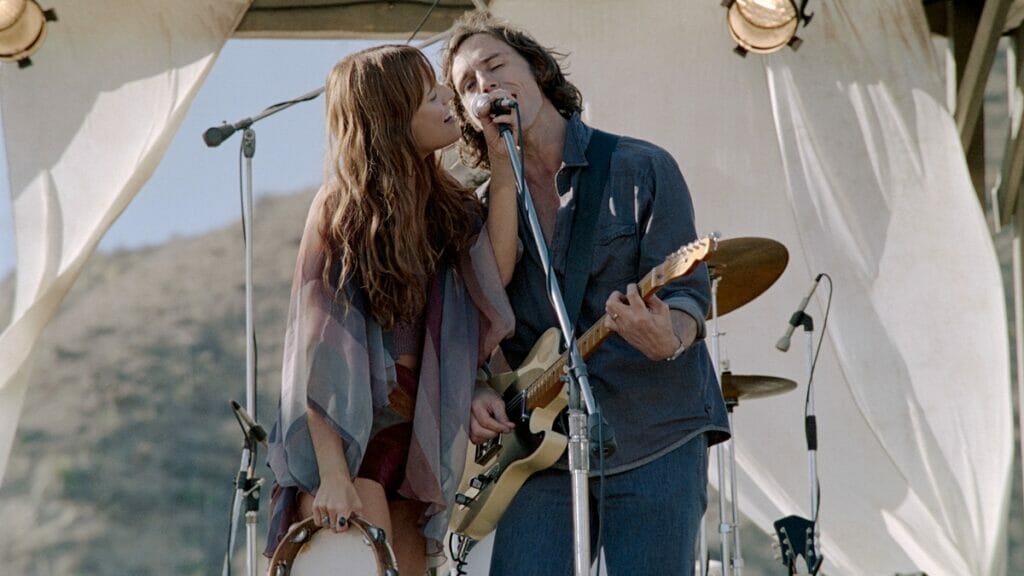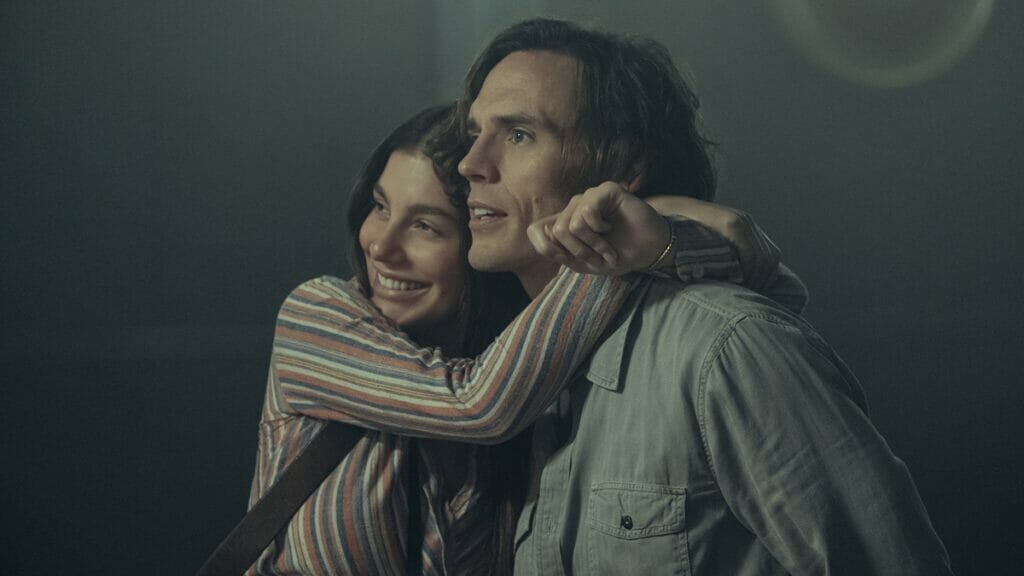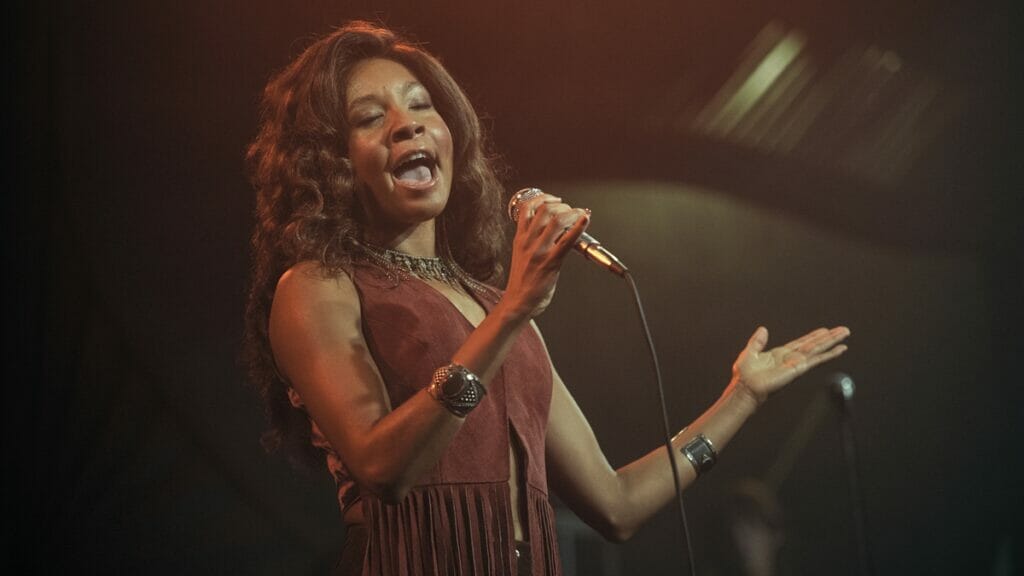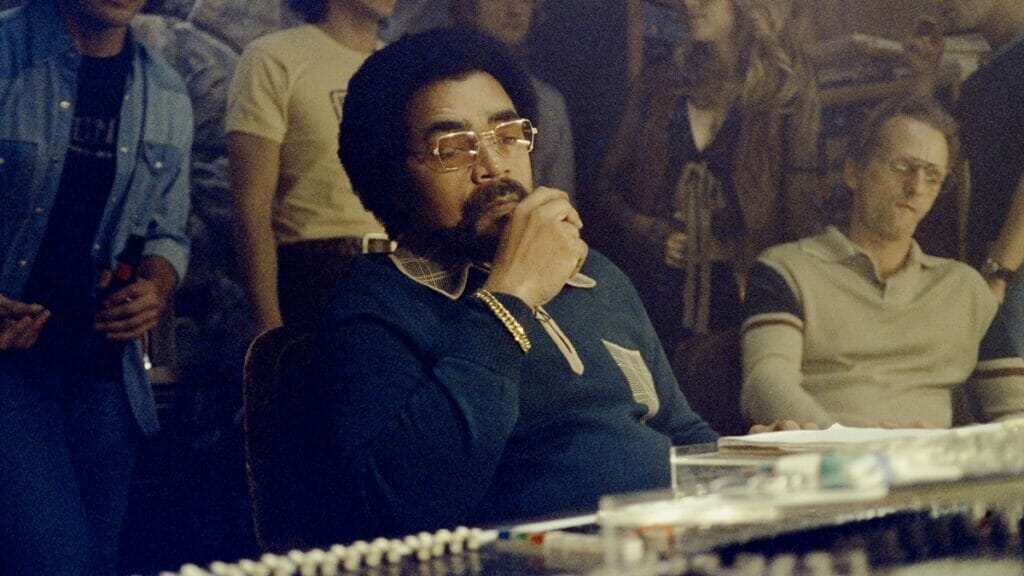Exploring how Prime Video’s band on the run drama captures and strays from the novel’s charms.
The story of Daisy Jones & The Six begins, fittingly, at its dramatic end. The show opens with the members of the titular band taking their seats for a series of talking-head interviews before a title card that reads, “On October 4, 1977, Daisy Jones and the Six performed to a sold-out crowd at Soldier Field in Chicago, Illinois.” Despite being one of the biggest bands in the world at that time, “It would be their final performance.” From there, we jump back in time to learn exactly how Daisy and the five members of the Six (yes, five) became a band.
Of course, this rock n’ roll drama is fictional. Still, fans who read the book of the same name could be forgiven for initially thinking otherwise. Taylor Jenkins Reid writes in a realistic faux-oral history style. Its prose is entirely composed of pretend interviews with the band’s members and the various industry types in their orbit as the story slowly focuses on the turbulent and complicated romance between the Six’s frontman, Billy Dunne (Sam Claflin), and charismatic rising star Daisy Jones (Riley Keough).
Daisy Jones was developed for television by Reese Witherspoon’s production company, Hello Sunshine, of the “women’s stories matter” meme. The Amazon version of Daisy Jones & The Six more or less ditches the smash hit novel’s signature oral history format. Only brief talking head interviews peppered throughout, and a small smattering of fake archival footage recalls that approach. The choice proves a mixed bag that may leave some devoted Six-heads—including myself— feeling cold.

It’s genuinely interesting to see the characters caught in their lies by the scenes that connect the interviews, amping up the concept of unreliable narration beyond what the book offers. Unfortunately, the primarily straightforward drama format also lightens the weight of some of the story’s cleverest and most dramatic moments, including the iconic reveal of the unnamed interviewer’s identity. It can also leave Daisy Jones feeling somewhat lacking as that style made it stand out in a sea of other tales about sexy, troubled rockstars.
Luckily, the show’s charismatic cast and thrilling musical performances save the day. Keough proves yet again that she is a captivating performer, bringing undeniable magnetism to the role of Daisy Jones. It’s hard to imagine anyone else playing the part. Daisy truly fits her like a glove. Nepotism baby discourse aside, Keough really is Elvis’ granddaughter, in terms of pure star power. Claflin is also well-cast as Daisy’s creative rival and love interest, Billy Dunne. His soulful eyes and heartbreaking smile make it easy to see why he’s become such a favorite in romantic movies over the years.
Newcomer Camila Morrone completes Daisy Jones & The Six’s central love triangle as Billy’s wife, Camila Dunne. Despite having only a few credits under her belt, Morrone absolutely shines in a role that could have been another thankless take on the put-upon music biopic wife. This should be her A Star is Born moment, the beginning of a rich career. She’s so warm and lovely that it’s impossible not to root for her. She completely sells that she’s the one holding the band together, despite not being a musician. Her anger and grief crackle through the screen, making it impossible to look anywhere else when she’s fighting with (or for) her husband.

In this reviewer’s opinion, Morrone and Claflin don’t have much in the way of sexual chemistry, especially compared to Claflin and Keough. It’s not that either Dunne is necessarily miscast. As stated above, they both bring needed empathy and nuance to their roles. Unfortunately, the age difference between the actors makes it tough to convince viewers they’re each others’ “first loves.” Instead, they look like two people at very different stages of their lives and act like it too.
Clafin and Keogh, on the other hand, have a wonderful, passionate dynamic that energizes the entire show. Watching a story about a man and woman connecting through the creative process is exciting. It feels rare. Stories about one artist and his fan (or her fan—but let’s face it, it’s usually a man) falling in love are already a dime a dozen. As Daisy herself proudly states, she’s not somebody’s muse: “I’m the somebody.” So instead of being shunted off to the sidelines while men write songs about her pretty eyes, Daisy gets to mix it up with Billy and make her voice heard. It’s a refreshing change for the genre, even if it feels like a no-brainer to the modern viewer. Almost Famous’ Penny Lane is iconic, but she’s already inspired more than enough “groupie” romances.
The spark between Daisy and Billy drives everything, leaving the installments before they meet feeling hollow. The show’s first episode is notably stilted, easily the low point of the entire series. In attempting to fill in the band members’ childhoods, which go only lightly touched on in the book, the show’s writers saddled characters with painfully on-the-nose lines. For example, Daisy’s cruel mother snarls, “No one wants to hear your voice!” while her young daughter sings. She might as well direct the line straight into the camera. It’s a frustrating and uninspired start to an otherwise enjoyable show. Happily, things look up after that, with the show finally kicking into high gear when Daisy links up with the Six to record their album, Aurora.
Luckily, the show’s charismatic cast and thrilling musical performances save the day.
The fleshed-out relationships between the band members, who include Billy’s brother Graham (Will Harrison) on guitar, bassist Eddie Roundtree (Josh Whitehouse), and Warren Rojas (Sebastian Chacon, stealing every scene he’s in), make Daisy Jones & The Six an appealing “hang out show.” Those scenes also serve to get audience members invested in the band’s survival, though we all know disaster awaits. Tom Wright brings a much-needed gravity to the show as wise producer turned mentor Teddy Price. Timothy Olyphant is hilariously zany in his small role as tour manager Rod Reyes.
Only keyboardist Karen Sirko (Suki Waterhouse) gets short shrift. In the book, Karen is a tomboy with a bitingly sarcastic, dry wit. She’s played very memorably by America’s Sweetheart Judy Greer in the impeccable full-cast audiobook. Here, she’s just another glamorous cool girl in fabulous clothes. Even her best clapback line goes to Daisy! Karen fans, let’s riot!
The somber material grossly underserved Waterhouse, who can be quite funny in interviews and online. As a result, the secret love affair between Karen and kind-hearted Graham, which served as a sort of foil to Daisy and Billy’s fiery dynamic, suffers.
The rapport between the female characters, on the other hand, is excellent. Camila and Daisy’s scenes with each other are arguably more fascinating than either’s relationship with Billy. They’re polar opposites who see each other clearly and respect each other deeply, despite being in love with the same man. The writers, who include Will Graham, of the superb A League of Their Own remake series, also made the intelligent choice to elevate Daisy’s best friend Simone Jackson (Nabiyah Be) from a small role to a supporting character with an arc of her own. Admittedly, it’s an arc that sometimes feels disconnected from the rest of the story of the Six, but it’s exciting to see Simone navigate the world of queer disco clubs in mid-70s New York City. Be also has the best voice in the show, putting even Keough to shame during their duets.

The Six’s music may not sound entirely authentically of the era. That likely can be chalked up to production that’s slightly too clean. Funnily enough, there’s even a scene where Daisy declares the music should sound “swampier”—she’s right. Putting this quibble aside, the new music composed for the show is excellent. Most importantly, they’re believable as hits. The entire story would crumble if viewers couldn’t buy into the idea that the central band created some classic songs. Earworms like “Regret Me” and “Look At Us Now” are more than up to the task. Aurora is an album someone could listen to and enjoy without knowing a thing about Daisy Jones & The Six, and that’s a high compliment.
Visually, there’s a lot to like as well. The sets are gorgeous and immediately pull you into the various cozy, artfully cluttered houses, California-chic hotels, and retro tour bus trips. The costumes look authentic and creative. The stagewear is particularly well-designed to play effectively with light, utilizing sheer fabrics and metallic sequins. Seeing a designer have as much fun with men’s fashion as the women’s is exciting. Band members of all genders wear fabulous suits, vests, and caftans.
It’s too bad that the digital film look flattens the show’s warm and varied textures. The digital medium feels deeply at odds with the rest of the aesthetics. Even the faux-archival footage looks Instagram-filtered. It’s hard to understand why, with an Amazon budget, the show doesn’t have a vintage look at least as decent as “Gentle and Soft,” the 1970s rock episode of IFC’s Documentary Now.

The bland style doesn’t do justice to James Ponsoldt (The Spectacular Now) and Nzingha Stewart’s (Little Fires Everywhere) thoughtful direction. Stewart’s work in the final episode is particularly skillful. The beautifully paced finale ratchets up the tension moment by moment until the concert-to-end-all-concerts arrives. A series of shots that pan across the band members’ faces while they struggle to conceal secrets from each other on their last tour bus ride stuck with me long after the episode’s end. Honestly, the show’s final ten minutes left me bawling, despite reading and listening to the book a half-dozen times.
Though the show sometimes feels overly padded, falling into the common miniseries adaptation trap of stretching a story that could have been eight episodes into ten, there are some inspired and unexpected additions to the source material that will keep fellow readers of the novel from feeling bored. Newcomers to the world of the Six will be eager to find out what happens to Daisy, Billy, and Camila, and old fans will feel like they’re hanging out with their buddies.
Experimenting with the mockumentary form would have been a big, bold swing. Nevertheless, the version of Daisy Jones & The Six we get is still lovely. It possesses a gentle, open-hearted view of love and relationships. And, of course, nothing tops the fantastic musical sequences.
If you end up dancing in front of the TV or singing “Regret You” on your morning commute, then Daisy Jones has succeeded. And you certainly won’t be alone.